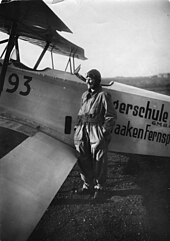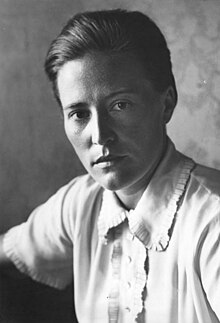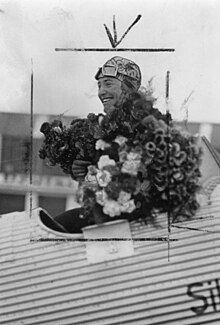Marga von Etzdorf


Margarete "Marga" Wolff gen. Von Etzdorf (* 1. August 1907 in Spandau ; † 28. May 1933 in Mouslimieh in Aleppo , Syria ) was a German aviator. In 1931 she was the first woman to fly a solo flight from Germany to Japan.
Life
Marga Wolff called von Etzdorf was the daughter of the royal Prussian captain Fritz Wolff and his wife Margarethe, née von Etzdorf . After the early accidental death of her parents in Ragusa in 1911 , she grew up with her sister Ursula with her grandparents, the royal Prussian infantry general Ulrich von Etzdorf , who was ennobled in 1910, and his wife on their estate near Gehren (Niederlausitz). Since 1920 she and her sister Ursula had been called Wolff gen. Von Etzdorf. Her uncle was Hasso von Etzdorf .
education
Marga Wolff gen. Von Etzdorf was a very sporty woman and interested in fencing, riding and hockey. At the age of 19 she decided to train as a pilot . In December 1927 she passed the exam after four months of training at the Bornemann flight school in Berlin-Staaken . She was thus by Thea Rasche , the second woman after the First World War , the pilot's license was A2. Probably she was also able to acquire the permit for class B1 there. She completed her training with an aerobatic license .
She then succeeded in becoming the first woman to get a job as a copilot at Lufthansa (DLH). In a Junkers F 13 she carried passengers on the routes Berlin – Breslau and Berlin – Stuttgart – Basel . After 10,000 kilometers by air, which was contractually agreed with DLH, she completed the further 5,000 kilometers required to acquire the B2 license with the Hamburg airline . To do this, she was the only candidate to answer questions from five examiners for three hours. She had taught herself the necessary knowledge because women were not allowed to attend the German Aviation School. She received support from Melitta Schiller , who worked as an engineer at the German Aviation Research Institute in Adlershof.
In 1929, at the suggestion of the Prince of Schaumburg-Lippe, she completed a glider training course . With a 90-minute flight on the Großer Heuberg (Swabian Alb), she was one of the first women in the world to acquire the glider-C license . In the same year she took part in the 10th Rhön competition with the "Hugo" glider of the Württemberg Flying Club , where she was listed in the jury's list of results with a premium of 50 Reichsmarks and a bonbonniere as an honorary prize.
First long-haul flights
In 1930, with the support of her grandparents, she bought her own aircraft, a Junkers A 50 ce "Junior" , with the serial number 3519 and the registration number D-1811, which she made bright yellow and which she named "Kiek in die Welt". First she used it for advertising, passenger and aerobatics . Her specialties included loops and flights on her back. In May 1930 she took part in the first German women's aerobatic championship, in which she was fourth. Soon, however, she was seized with long-distance fever. In the same year she flew to Istanbul with her "Junior" . Problems with the engine forced them to make emergency landings several times. After a long stay in Istanbul, however, she was able to fly back to Germany without any further problems. However, her application with this flight for the Hindenburg Cup , the highest German sporting flight award, had to be rejected because, contrary to the rules, her aircraft did not have a German engine.
Soon after, she was preparing her second long haul flight. “Kiek in die Welt” received larger tanks in order to extend the range and avoid emergency landings due to a lack of petrol. On November 14, 1930, Marga von Etzdorf took off from Berlin and flew via Basel and Lyon to Madrid . Since the direct route from Spain to Las Palmas de Gran Canaria was still too long, she had to stop in Rabat (Morocco) to refuel before she was enthusiastically received on 6 December when she landed in the Canary Islands . Difficulties only arose on the return flight: Severe storms over the Mediterranean forced them to make an emergency landing in Sicily . When taking off from a wet meadow the next day, a wing touched a wall, which led to the involuntary abortion. The machine was badly damaged and, since spare parts were not available, it had to be brought back to the Junkers factory in Dessau in Germany .
Berlin – Tokyo
Marga von Etzdorf began in 1931 to prepare a spectacular record flight to Tokyo for sport aviation in the Weimar Republic . It was not just a matter of obtaining overflight permits for all countries, but also securing the company's financing.
On August 18, 1931, it started without much fuss in Berlin. Because of the bad weather, she had to make a stopover in Königsberg after just three hours . Eleven hours later, she reached her first stage destination, Moscow . From there she flew via Nizhny Novgorod along the Volga to Kazan . On the third day of her trip, she crossed the Urals and then followed the line of the Trans-Siberian Railway to Novosibirsk . In Hailar near the Mongolian border, she was amazed at the press present, which was not waiting for her, but for the British long-haul pilot Amy Johnson , who was also on her way to Tokyo. Since Johnson flew in the company of her mechanic, Marga von Etzdorf was recognized as the first solo flight by a woman to Japan. The next day she flew over the taiga and reached Lake Baikal . The next stop was Mukden , where she had to take a day off because the entry documents required for Japan had not yet arrived. She landed one more time in Korea to refuel before venturing across the Japanese Sea. She landed in Hiroshima that evening . The next destination was Osaka and from there Tokyo , which she could not fly directly to because of the many restricted military areas.
On August 29, 1931, Marga von Etzdorf reached the Japanese capital after 12 days (11 days of flight). Thousands of people greeted the record flyer at Tokyo Airport.
After a six-week stay and a general overhaul of her aircraft, Marga von Etzdorf then went on the flight home. She was initially stuck in China for months because of political turmoil. When she was finally able to fly on, she wanted to visit friends in Bangkok . At the start in Bangkok, however, the engine of her "Junior" cut out and she fell from a height of about 80 m. She was seriously injured in the process, especially her spine. The plane was a total write-off. She was under medical treatment in the capital of Siam for months . Since “Kiek in die Welt” could no longer be saved, she finally flew back to Berlin in an airliner.
Hans Bertram writes in his book Flight to Hell that he visited Marga von Etzdorf shortly after the accident on April 4, 1932 in the hospital in Bangkok.
After the flight to Japan
In July 1932, Marga von Etzdorf personally welcomed her colleague, record pilot Elly Beinhorn , when she returned from her world flight. In the months that followed, she gave lectures on her flight to Japan in order to fill the empty coffers again. A new plan was growing in her head: She wanted to fly to Cape Town , for which she had already made preparations. But when she found out that Elly Beinhorn also wanted to go to this destination, she tried to fly solo to Australia .
After long negotiations, the Leichtflugzeugbau Klemm company in Böblingen provided her with a Klemm Kl 32 . It started on May 27, 1933, well prepared, from Berlin-Staaken .
But the very next day her plane was damaged when landing at Mouslimieh airfield near Aleppo ( Syria ) operated by the French mandate administration because it landed with the wind. A repair would have been possible. After completing the formalities, however, she is said to have asked the airport police for a room where she could lie down for "half an hour". As soon as she was alone, Marga von Etzdorf prepared the machine pistol she was carrying ( Schmeisser 28 / II , 9 mm) and put an end to her life with two targeted shots in the temple. Her body was embalmed and brought back to Europe by ship in the coffin, along with her aviator uniform.
After a solemn lay-up in Hamburg and a funeral service in the Protestant chapel of the Berlin Invalidenhaus , a few months after the NSDAP came to power with great sympathy a. a. The SA and SS laid to rest in the local invalids' cemetery. Her tombstone bears the inscription of her own choosing: "The flight is worth living." The tombstone, which was destroyed by the expansion of the barriers on the Berlin Wall in the 1970s, was reconstructed in 2003.
There has been much speculation about the reasons for the suicide: Another return without a plane would have destroyed her reputation as a pilot - no manufacturer would have entrusted her with a machine, no sponsor would have given her financial support again. The flying career of the 25-year-old would have come to an end. A letter from Ernst Heymann (retired captain and employee of the Haenel armaments company ) was found in her last luggage . From Heymann's letter it emerged that the submachine gun should not only be used for self-defense, but above all for illegal negotiations for the sale of Schmeisser submachine guns. In addition to accessories and 100 rounds of ammunition, German and English catalogs and price lists were enclosed. She should also earn money from any sales. Carrying the submachine gun for private use would only have been permitted with the permission of the country overflown. The trade in such weapons also violated fundamental provisions of the Versailles Treaty . The Foreign Office , which had sent a diplomat to Aleppo, was well aware of the explosiveness of this situation. It is now assumed that one of the reasons for the suicide was the fear of discovery and propaganda exploitation by the French authorities. After death, they refused to capitalize on the incident. For decades, weapons smuggling was never published or discussed in Germany.
She had received several high awards for her flying achievements. In Japan she had received the rarely awarded "Golden Merit Medal" from the Imperial Japanese Aero Club. The Aero Club of Germany bestowed her with the “Golden Honor Plaque”, its highest award.
literature
- Marga von Etzdorf: Kiek into the world. As a German aviator over three continents . Union, Berlin 1931.
- Evelyn Zegenhagen: "Dashing German Girls": Aviators between 1918 and 1945 . Wallstein, Göttingen 2007, ISBN 978-3-8353-0179-5 , pp. 166–176 (partial view on Google Books ).
- Alice Bota: Pilot Marga von Etzdorf: The flight is worth life . In: The time . February 2, 2014, ISSN 0044-2070 ( zeit.de [accessed February 11, 2019]).
- Uwe Timm : penumbra . Kiepenheuer & Witsch, Cologne 2008, ISBN 978-3-462-04043-2 . Novel about the life of Marga von Etzdorf.
- Tribe series of the von Etzdorf family in: Gothaisches Genealogisches Taschenbuch der Adeligen Häuser , Part B, 1935, p. 164 ff.
- AERO International No. 3/2018, pp. 74-75
Web links
- Literature by and about Marga von Etzdorf in the catalog of the German National Library
- FemBiografie Marga von Etzdorf with quotes, links and literature
- The daring sisters of Ikarus Frankfurter Allgemeine Zeitung , August 3, 2006
- 100th birthday of Elly Beinhorn. ( German broadcast archive - sound documents, including recordings with Marga von Etzdorf. Last checked on May 24, 2010)
- Alica Bota: The flight is worth life, in: Die ZEIT online 05/2014 Jan. 29, 2014, accessed on February 11, 2019
- Sybille Dörr: Marga von Etzdorf. http://www.fembio.org/biographie.php/frau/biographie/marga-von-etzdorf/ accessed on February 11, 2019
Individual evidence
- ↑ Hans Bertram: Flight into hell . Drei Masken Verlag AG, Berlin 1933, p. 74.
- ↑ Alice Bota: Pilot Marga von Etzdorf: The flight is worth life . In: The time . February 2, 2014, ISSN 0044-2070 ( zeit.de [accessed February 11, 2019]).
- ↑ Evelyn Zegenhagen: "Dashing German Girls": female pilots between 1918 and 1945 . Wallstein, Göttingen 2007, ISBN 978-3-8353-0179-5 , pp. 174–175 (partial view on Google Books ). Your information is largely based on a file in the Political Archive of the Foreign Office (R 32480), which also contains the text of Heymann's letter printed on p. 174, note 121.
- ↑ Zegenhagen, p. 175
- ↑ Zegenhagen, p. 175
- ↑ Home - Female personalities in Berlin Mitte. Retrieved February 11, 2019 .
| personal data | |
|---|---|
| SURNAME | Etzdorf, Marga von |
| ALTERNATIVE NAMES | Wolff called von Etzdorf, Margarete (full name) |
| BRIEF DESCRIPTION | German aviator |
| DATE OF BIRTH | August 1, 1907 |
| PLACE OF BIRTH | Berlin-Spandau |
| DATE OF DEATH | May 28, 1933 |
| Place of death | Mouslimieh near Aleppo , Syria |





